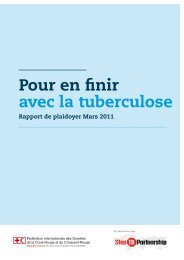Guidelines for intensified tuberculosis case-finding and isoniazid ...
Guidelines for intensified tuberculosis case-finding and isoniazid ...
Guidelines for intensified tuberculosis case-finding and isoniazid ...
Create successful ePaper yourself
Turn your PDF publications into a flip-book with our unique Google optimized e-Paper software.
2. Intensified <strong>case</strong>-<strong>finding</strong> <strong>for</strong> <strong>and</strong> prevention of<br />
<strong>tuberculosis</strong> in adults <strong>and</strong> adolescents living<br />
with HIV<br />
2.1 Screening <strong>for</strong> TB<br />
Adults <strong>and</strong> adolescents living with HIV should be screened <strong>for</strong> TB with a<br />
clinical algorithm <strong>and</strong> those who do not report any one of the symptoms<br />
of current cough, fever, weight loss or night sweats are unlikely to have<br />
active TB <strong>and</strong> should be offered IPT.<br />
Strong recommendation, moderate quality of evidence<br />
Adults <strong>and</strong> adolescents living with HIV <strong>and</strong> screened <strong>for</strong> TB with a<br />
clinical algorithm <strong>and</strong> who report any one of the symptoms of current<br />
cough, fever, weight loss or night sweats may have active TB <strong>and</strong><br />
should be evaluated <strong>for</strong> TB <strong>and</strong> other diseases.<br />
Strong recommendation, moderate quality of evidence<br />
All people living with HIV, wherever they receive<br />
care, should be regularly screened <strong>for</strong> TB using a<br />
clinical algorithm at every visit to a health facility or<br />
contact with a health worker. Screening <strong>for</strong> TB is<br />
important, regardless of whether they have received<br />
or are receiving IPT or ART. As part of the guidelines<br />
development process, a comprehensive systematic<br />
primary patient data meta-analysis, including 12<br />
observational studies involving over 8000 people<br />
living with HIV, was used to develop the best<br />
screening rule to identify adults <strong>and</strong> adolescents<br />
living with HIV who are unlikely to have active TB<br />
disease (Annex 5).[15] The analysis found that the<br />
absence of all the symptoms of current cough, night<br />
sweats, fever or weight loss can identify a subset of<br />
people living with HIV who have a very low probability<br />
of having TB disease. This best screening rule has<br />
a sensitivity of 79% <strong>and</strong> a specificity of 50%. At<br />
5% TB prevalence among people living with HIV,<br />
the negative predictive value was 97.7% (95%CI<br />
97.4–98.0). This high negative predictive value<br />
ensures that those who are negative on screening<br />
are unlikely to have TB <strong>and</strong> hence can reliably start<br />
IPT. There<strong>for</strong>e, the <strong>Guidelines</strong> Group recommends<br />
that adults <strong>and</strong> adolescents living with HIV should be<br />
screened <strong>for</strong> TB using a clinical algorithm at every<br />
visit to a health facility or contact with a health worker.<br />
Those who do not have current cough, fever, weight<br />
loss or night sweats are unlikely to have active TB<br />
<strong>and</strong> should be offered IPT. This recommendation is<br />
applicable <strong>for</strong> those living with HIV irrespective of the<br />
degree of immunosuppression, <strong>and</strong> <strong>for</strong> those on ART,<br />
those who have previously been treated <strong>for</strong> TB <strong>and</strong><br />
pregnant women (Figure 1).<br />
Furthermore, the GRADE assessment of the evidence<br />
showed that the addition of abnormal <strong>finding</strong>s on chest<br />
radiography to the four-symptom-based rule increases<br />
the sensitivity from 79% to 91% with a drop in specificity<br />
from 50% to 39%. At a 5% TB prevalence rate among<br />
people living with HIV, augmenting the symptom-based<br />
rule with abnormal <strong>finding</strong>s on chest radiography<br />
increases the negative predictive value by a margin of<br />
only 1% (98.7% versus 97.8%). On the other h<strong>and</strong>, the<br />
addition of abnormal chest radiographic <strong>finding</strong>s to the<br />
symptom-based rule at a TB prevalence of 20% among<br />
people living with HIV increases the negative predictive<br />
value by almost 4% (94.3% versus 90.4%). This<br />
suggests that chest radiography could be considered<br />
to augment the utility of symptom-based screening<br />
in settings with high TB prevalence rates among<br />
people living with HIV. However, the <strong>Guidelines</strong> Group<br />
recognized that the desire <strong>for</strong> increased sensitivity<br />
<strong>and</strong> negative predictive value is often accompanied by<br />
significant feasibility concerns such as cost, workload,<br />
infrastructure <strong>and</strong> qualified staff. There<strong>for</strong>e, the<br />
<strong>Guidelines</strong> Group recommends that in most settings,<br />
the symptom-based rule should be implemented,<br />
15


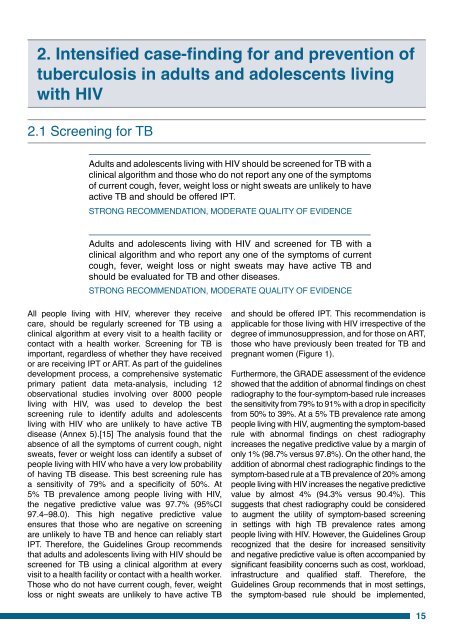
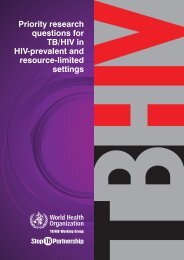
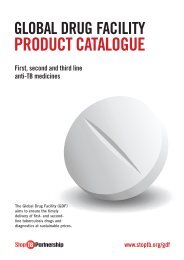
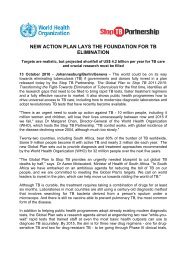
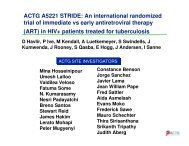
![Global Drug Facility Annual Report 2011 [.pdf] - Stop TB Partnership](https://img.yumpu.com/26788745/1/184x260/global-drug-facility-annual-report-2011-pdf-stop-tb-partnership.jpg?quality=85)
![Concept note on national stop TB partnership [.pdf]](https://img.yumpu.com/26788741/1/184x260/concept-note-on-national-stop-tb-partnership-pdf.jpg?quality=85)
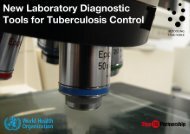

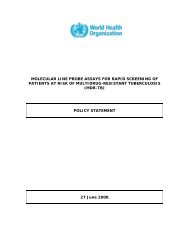
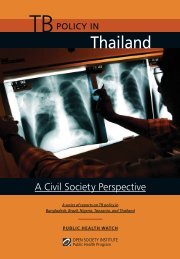
![2005 and Challenges for 2006 - 2015 [.pdf] - Stop TB Partnership](https://img.yumpu.com/26788674/1/190x245/2005-and-challenges-for-2006-2015-pdf-stop-tb-partnership.jpg?quality=85)
![Brochure (French) [.pdf] - Stop TB Partnership](https://img.yumpu.com/17234792/1/190x91/brochure-french-pdf-stop-tb-partnership.jpg?quality=85)

